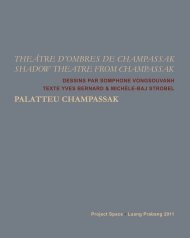LE GENIE AU BOUT DES CISEAUX ThE GENIE BEhIND ThE ...
LE GENIE AU BOUT DES CISEAUX ThE GENIE BEhIND ThE ...
LE GENIE AU BOUT DES CISEAUX ThE GENIE BEhIND ThE ...
Create successful ePaper yourself
Turn your PDF publications into a flip-book with our unique Google optimized e-Paper software.
Les motifs sont-ils des esprits ?<br />
La plupart des tissus hmong, qu’ils soient brodés, appliqués<br />
ou en batik ont prioritairement une destination vestimentaire.<br />
Les différents points (arrière, lancé, dit « de Pékin », de trait,<br />
de croix) permettent en effet une déclinaison infinie de motifs<br />
géométriques, en bandes parallèles ou en carré, avec ou<br />
sans bordure. D’autres ont vocation d’accessoires : pochettes,<br />
ceintures, bonnets, porte-bébé, couvertures. De manière assez<br />
discrète chez les hommes, mais bien plus élaborée et chargée<br />
de détails et de variantes chez les femmes et les enfants,<br />
les lignes et couleurs des motifs, reposent sur un répertoire<br />
essentiellement géométrique et linéaire aboutissant parfois à<br />
une surenchère proche de la virtuosité. Les motifs les plus<br />
complexes, à base de points, chevrons, spirales, entrelacs, cercles,<br />
rectangles ou triangles se disputent les surfaces de tissu<br />
jusqu’à devenir relief ou volume. Les costumes du Nouvel<br />
An sont particulièrement chargés et obéissent à une véritable<br />
mise en scène corporelle. Cependant aucun des motifs portés<br />
par les hommes, femmes ou enfants ne reprennent des figures<br />
anthropomorphes ou animales telles qu’on les voit sur<br />
les tentures de Tcheu Siong. D’où proviennent donc ces figures<br />
animalières, aux bras multiples parfois, aux jambes repliées,<br />
avec des petits personnages inclus dans leur ventre ou<br />
sortant de leurs troncs ?<br />
« L’âme voyage et la mort est avant tout un voyage de l’âme qui a survécu<br />
au corps, vers une autre existence. Voyage donc aux sources de la<br />
vie. Chez les Hmong, le but du voyage est nommément le village et la<br />
maison des ancêtres. » (Lemoine, 1983 : 6).<br />
using points, arrows, spirals, interlocking circles, rectangles<br />
and triangles, all competing across the surface of the fabric<br />
often so thickly as to be embossed and quite prominent. New<br />
Years costumes are like wearable theatre. However, none of<br />
these designs worn by men, women or children repeat the<br />
anthropomorphic or animal figures such as one sees in Tcheu<br />
Siong’s work.<br />
So where do these figures come from, animal-like, many-armed,<br />
bent-legged with many more small creatures clinging to<br />
their legs and torsos?<br />
“The soul travels, and death is in fact a voyage of the soul which has<br />
outlived the body and is heading towards another existence. Among the<br />
Hmong, the end of the voyage is specifically the village and the home of<br />
the ancestors.” (Lemoine, 1983: 6)<br />
The question of wandering souls is obviously complicated<br />
and not easy to describe. One cannot imagine how many<br />
there must be. Of course they are all echoes from the human<br />
world:<br />
“All aspects of human life are explained by the presence of souls. …<br />
In other words, even outside the world of men, all manifestations of<br />
life and growth, all that is animated is endowed with a soul and, as a<br />
result, the boundaries between the individual and the surrounding world<br />
are deceptions.” (Moréchand, 1968: 122)<br />
What the shaman does is to communicate with the world outside<br />
of the everyday, an invisible universe peopled by gods,<br />
spirits, ghosts and ancestors. It’s this wisdom and familiarity<br />
with the ‘‘others’’ that allows him to decipher the signs that<br />
9



